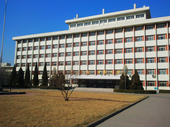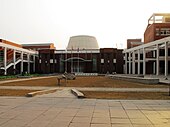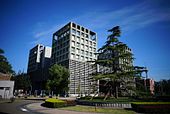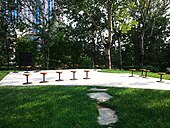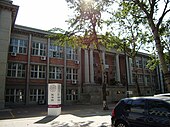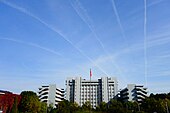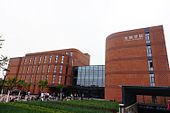Nankai University
This articlecontainsacademic boosterismwhich primarily serves topraise or promote the subjectand may be a sign of aconflict of interest.(July 2023) |
Nam khai đại học | |
 | |
| Motto | Duẫn công duẫn năng, nhật tân nguyệt dị[1] |
|---|---|
Motto in English | Dedication to Public Interests, Acquisition of All-round Capability, Aspiration for Progress with Each Passing Day[1] |
| Type | National,Public |
| Established | 1919 |
| President | Chen Yulu |
Academic staff | 2,286 |
| Undergraduates | 17,339 |
| Postgraduates | 17,467 |
| Location | , China |
| Campus | Balitai, Jinnan, TEDA |
| Website | nankai.edu.cn |
| Nankai University | |||||||||
|---|---|---|---|---|---|---|---|---|---|
| Simplified Chinese | Nam khai đại học | ||||||||
| Traditional Chinese | Nam khai đại học | ||||||||
| |||||||||
Nankai Universityis a public university inTianjin, China.It is affiliated with theMinistry of Education of China.The university is part ofProject 211,Project 985,and theDouble First-Class Construction.[2][3]
Nankai University was established in 1919 as the private Nankai School byYan XiuandZhang Boling.During theSecond Sino-Japanese War from 1937 to 1945,Nankai University,Peking UniversityandTsinghua Universitymerged and formed the National Changsha Provisional University, which later moved toKunmingand was renamed the National Southwestern Associated University ( tây nam liên đại ). On December 25, 2000, the State Ministry of Education signed an agreement with Tianjin Municipal Government to jointly establish and develop Nankai University.
Nankai's alumni include the firstPremier of the People's Republic of ChinaZhou Enlai,mathematicianShiing-Shen Chernand Nobel laureatesChen Ning YangandTsung-Dao Lee.[4][5][6][7]
History[edit]

This sectionneeds additional citations forverification.(July 2018) |
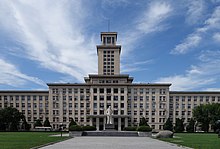
1919–1937[edit]
The university was founded as a private institution in 1919.[8]Nankai's scale was relatively small at its inception partly because it received no funding from the government but instead was funded by foreign charitable funds and local entrepreneurs, with only 3 departments (liberal arts, science, and business) and 96 students.[9]It was noted particularly for its courses which were taught in English using foreign curricula and textbooks.[10][citation needed]
The well-knownNankai Institute of Economicswas established in 1927 and soon became one of the most prominent[11]in China being the first non-foreign entity to calculate a Chinese Consumer Price Index.[12]
By 1937, Nankai had expanded into a university of 3 colleges, 13 departments, and 2 research institutes, with 429 students and 110 faculty and staff members.[9]
It was once nicknamed "The North Star of Higher Learning".[13]
1937–1949[edit]
In July 1937, during theSino-Japanese War,Nankai campus was severely damaged by Japanese bombings.[14][15][16][17][18][19][20][21]About two-thirds of Nankai's school buildings including its library were destroyed by the Japanese Imperial Army. A number of the school's artifacts, including the university bell,[22][23][24]were looted and remain in Japanese museums till this day.[citation needed]
In August 1937, still during the Sino-Japanese War, Nankai University,Peking UniversityandTsinghua Universityunited to form theNational Changsha Provisional University,which later moved toKunmingand was renamed theNational Southwestern Associated University.[25][26][27][28]On April 2, it was renamed "National Southwestern Associated University.[27]In 1946, after the war, Nankai returned toTianjinand was reformed into a national university by the government.[29]At that time, Nankai had four schools (Liberal Arts, Science, Political Science and Economics, and Engineering) and 16 departments.[30]
1949–1966[edit]
After the establishment of the People's Republic of China, Nankai was readjusted and became a comprehensive university with emphasis on the arts and sciences, with 14 departments and 3 professional specialties in total.[9]
1966–1976[edit]
From 1966 to 1976 the School's normal life was out of order due to theCultural Revolution.[9]In 1976 acatastrophic earthquake broke out in Tangshan,bordering Tianjin, causing damage of varying degrees to the School's buildings.[9]
1976–present[edit]

In February 1978, the State Council decided to resume and set up national key colleges, Nankai University is identified as the first national key college.[31]
After 1980, Nankai added a number of new specialties and institutes. In arts, applied specialties on financing were set up and the School of Economics was reopened in 1983, while in Sciences, interdisciplinary, marginal and high and new technological specialties were added.
Nankai was among the first universities in China to open its doors for students from America in the 1980s.[32]In 1989 the university was ordered by the Tianjin public security bureau to send two Americans back home, following rising political tensions over pro-democracy demonstrations.[33]
By the late 1980s, Nankai University had grown to be a comprehensive university embracing Humanities, Natural Sciences, Applied Sciences, Life Sciences, Managements and Art.
In 1994 Tianjin Foreign Trade College was merged to Nankai university. In 1999 under the combined efforts of Nankai andTEDA,TEDA College was set up. In 2000 the State Ministry of Education signed an agreement with Tianjin Municipal Government on jointly establishing and developing Nankai University. Experimental cooperation between Nankai University and Tianjin University was initiated on the principle of independent school-running and close cooperation. In 2002 under the cooperative efforts of Nankai, Government ofShenzhenandUC Berkeley,the Financial Engineering College was established in Shenzhen.
In May 2006 Nankai's presidentRao Zihetendered 15 of the 21 university's college dean positions, restaffing key positions in an effort to further improve the university's educational programs.[34]
In February 2015, following Chinese media reports and statements from inside the Chinese Communist Party that universities would have to "be cleansed of liberal Western textbooks and other ideological heresies", Nankai's president Gong Ke publicly stated: "Recently I've read people on the Internet saying that the ranks of academics must be cleansed, purified and rectified. I can't agree with this. This was the mentality of 1957 or 1966." and "We cannot re-enact this history of" leftist "errors against intellectuals."[35][36]
-
Nankai University Yingshuidao Campus
-
Nankai University TEDA college
-
Joint Research Building ofTianjin Universityand Nankai University
-
Cemetery ofShiing-shen Chern
-
Siyuan building
Campus[edit]
This sectionneeds additional citations forverification.(June 2021) |
Nankai university encompasses three campuses. Balitai, Jinnan and TEDA.[37]The total local campus area is 456.1 and the building area 136.8 hectare.[38]
Balitai campus[edit]
Balitai was Nankai's first campus. established in 1919 and is located at Balitai in the Nankai district of Taijin. The campus hosts 10 colleges, namely the Business School, School of Economics, School of Literature, College of Chemistry, School of Mathematical Sciences, Institute of Physics, College of Foreign Languages, College of Life Sciences and Institute of Japan Studies.[39]
Jinnan campus[edit]
Jinnan campus is the latest campus of Nankai university. It was opened in September 2015 and is located in the jinnan Area. The campus hosts 14 colleges, the Zhou Enlai School of Government, College of Tourism and Service Management, School of Medicine, College of Pharmacy, Law School, College of Chinese Language and Culture, Faculty of Philosophy, College of History, College of Computer and Control Engineering, College of Electronic Information and Optical Engineering, School of Material Science and Engineering, School of Finance and College of Software.[40]
TEDA campus[edit]
TEDA campus is also located in the Binhai New Area and hosts the TEDA Institute of Biological Sciences and Biotechnology and the TEDA Institute of Applied Physics.[41]
Academics[edit]
This sectionneeds additional citations forverification.(June 2021) |
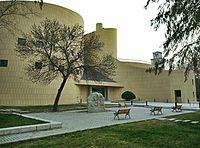
Nankai is a multidisciplinary university under the jurisdiction of the Ministry of Education.[42][citation needed]
Teaching and Learning[edit]
The university has academic programs that cover the humanities, natural sciences, technology, life sciences, medical sciences and the arts, with an equal balance between the sciences and the liberal arts.[43]
Nankai's academic programs operate on a semester calendar, with two terms. The first beginning in early September and ending in early January and the second beginning in early February and ending in early July. Subsequently, winter break usually ranges from early January to early February and summer break from early July to early September.[44]
Nankai, in 2013, had 22 colleges and schools, and offered 79 bachelor's degree programs, 231 master's degree programs, and 172 PhD programs. The total enrollment stood at approximately 12,000 undergraduate students and 11,000 graduate students. Of the total student population, 10% were international students from different countries around the world.
In 2018 the university offered a total of 80 undergraduate programs, 231 Master and 172 PhD programs and 28 post doctoral research stations. The total count of full-time students was 24,525. Academic staff consisted of 1,986 full-time teaching personnel, with 214 professors and 805 associate professors.[38]
Nankai offers different scholarships, among them the Chinese Government Scholarship for international students,[45]the CSC Scholarship for American Students,[46]the Tianjin Government Scholarship,[47]the Confucius Institute Scholarship[48]and the Nankai University Scholarship.[49]
Nankai also offers several scholarship programs to support international exchanges and hosts different international student exchange programs.[50]Nankai's broad international programs are organized through the International Office. The university has established cooperations with more than 300 international universities and academic institutions, including programs like an Elementary School Chinese Program with schools in the US, which was launched in 2009.[51][52][53][54]In 2010 the US-China exchange program Study International was launched, with the plan to send 100,000 American students to china in a four-year time frame. The first students were sent to Nankai university in the fall of 2010.
In 2012 Nankai was invited to become the 35th member of The Global University Leaders Forum (GULF), a global community of high-ranking universities, including renowned members likeYale University,Harvard Universityand theUniversity of Oxford.[55][additional citation(s) needed]

Research[edit]
The university has established broad international exchanges and collaborative relationships with more than 200 universities and academic institutions. Nobel LaureatesChen Ning Yang,Tsung-Dao Lee,Samuel Chao Chung Ting,Robert A. Mundell,andReinhard Seltenas well as former President of KoreaKim Dae Jungand former US Secretary of StateHenry Kissingerwere all conferred Honorary Professorships by Nankai University.[56]
In November 2016Robert F. Engle,who won the 2003 Nobel Prize in economics, became an honorary professor at Nankai.[57]
Many other world-known scholars and entrepreneurs have been invited as Visiting Professors at Nankai University. Dr. Heng-Kang Sang returned from the United States to found the College of Economic and Social Development in 1987. Nankai University, a magnet for talented mathematicians known both at home and abroad, has become one of the most famous centers for mathematics worldwide.
Nankai established nineConfucius Institutesaround the world.[58][citation needed]
Scientists from Nankai have been involved in different scientific breakthroughs and important advancements.[59][60][61]
Rankings and reputation[edit]
| BCURNational[62] | Domestic | 21 | |
|---|---|---|---|
| Wu ShulianNational[63] | Domestic | 24 | |
| CUAANational[64] | Alumni | 9 | |
| QSNational[65] | General | 20 | |
| THENational[66] | General | 17–20 | |
| QSAsia (Asia version)[67] | General | 92 | |
| THEAsia (Asia version)[68] | General | 55 | |
| ARWUWorld[69] | Research | 151–200 | |
| QSWorld[70] | General | =377 | |
| THEWorld[71] | General | 251–300 | |
| USNWRWorld[72] | General | =256 | |

Nankai University is ranked among the top 10 universities in China, with exceptions in 2017 and 2018.[6]In the ranking of top 50 universities in China published byRenmin University of Chinain June 2011, it was ranked 10th.[4]In theNetbig rankingof 2011 it was ranked 10th as well.[5]In theQS World University Rankingsof 2013 it was ranked 62nd among Asian universities, and 11th in China.[6]In the Chinese first-class university ranking of 2012 byWu Shulianof China Management Academy, it was placed 8th.[7]In theCWTS Leiden Ranking2013, it was ranked 53rd among world universities, and 1st in China.[73]In theNature IndexGlobal 2014, it was ranked 83rd among world universities, and 7th in China.[74]
Department rankings[edit]
The university is also highly regarded for its top quality undergraduate programs.[75]Nankai's mathematics, chemistry,[76]history, business and economics programs are among the best in China.[75][77][78]
Chern, Shiing-Shenestablished the world's largest mathematics institute (in terms of office area) in Nankai University.[79][citation needed]
Student life[edit]
Student body[edit]
In 2018 Nankai enrolled 24,525 full-time students, with 13,067 undergraduate, 8,162 postgraduate and 3,296 PhD students. Of them 1,902 were international students.[80][citation needed]
Colleges and schools[edit]
This sectionneeds additional citations forverification.(June 2021) |
|
|
People[edit]
Presidents[edit]

- Zhang Boling( trương bá linh ): 1919–48
- He Lian( hà liêm ): 1948–57 (acting)
- Yang Shixian ( dương thạch tiên): 1957–1969
- vacantdue to theCultural Revolution:1969–1978
- Zang Boping ( tang bá bình ):1978
- Yang Shixian (second term): 1979–1981
- Teng Weizao ( đằng duy tảo): 1981–1986
- Mu Guoguang( mẫu quốc quang ): 1986–1995
- Hou Zixin( hầu tự tân ): 1995–2006
- Rao Zihe ( nhiêu tử hòa ):2006–2011
- Gong Ke ( cung khắc ):2011–2018[82]
- Cao Xuetao ( tào tuyết đào ):2018–2022[83]
- Chen Yulu ( trần vũ lộ ):2022–[84]
Notable alumni[edit]

Notable alumni of Nankai university include
- Wang Anshun,Chinese politician and former mayor of Beijing[85]
- Jerome Chen,Chinese historian and fellow of theRoyal Society of Canada[86]
- Shiing-Shen Chern,Chinese mathematician regarded as a leader ingeometryand one of the greatest mathematicians of the twentieth century[87]
- Chow Chung-cheng,Chinese artist and author
- Zhou Enlai,Chinese politician and firstPremier of the People's Republic of China[88][89]
- Tsung-Dao Lee,Chinese-Americanphysicistand winner of theNobel Prize in Physicsin 1957 (together withChen-Ning Yang)[90]
- Ray Huang,Chinese philosopher and historian
- Li Jinyuan,Chinese businessman and billionaire
- David X. Li,Chinese statistician
- Guo Shuqing,Chinese politician, banker and formerly served as the Governor andDeputy Party SecretaryofShandong,chairman of theChina Securities Regulatory Commission(CSRC)[91]
- Wu Ta-You,Chinese atomic and nuclear theoreticalphysicistwho worked in the United States, Canada,mainland ChinaandTaiwanand has been dubbed the "Father of Chinese Physics"
- Zhang Wenzhong,Chinese businessman and scholar
- Liu Xinyuan,Chinesemolecular biologist
- Ren Xuefeng,Chinese politician and business executive who served as theCommunist Party Secretaryof Guangzhou and theDeputy Communist Party SecretaryofGuangdong
- Cao Yu,Chinese playwright, often regarded as China's Shakespeare and one of the most important playwrights of the 20th century[92][93]
- Chen-Ning Yang,Chinesephysicistand winner of theNobel Prize in Physicsin 1957 (together withTsung-Dao Lee)[94][90]
- Dou Yupei,Chinese politician and formerVice Minister of Civil Affairs
- Xiaowen Zeng,Chinese-Canadian author
- Zhang Yiming,Chinese businessman, founder and former CEO ofByteDance[95]
A more extensive list of Nankai alumni can be foundhere.
See also[edit]
References[edit]
- ^ab"Nankai Motto".RetrievedJuly 19,2018.
- ^"Nankai University".China Admissions.RetrievedJuly 25,2020.
- ^"Giáo dục bộ tài chính bộ quốc gia phát triển cải cách ủy quan vu công bố thế giới nhất lưu đại học hòa nhất lưu học khoa kiến thiết cao giáo cập kiến thiết học khoa danh đan đích thông tri - trung hoa nhân dân cộng hòa quốc giáo dục bộ chính phủ môn hộ võng trạm".www.moe.gov.cn.
- ^ab"Renmin University of China Higher Education Research".plan.ruc.edu.cn(in Chinese).RetrievedJuly 6,2011.
- ^ab"Netbig 2011 Chinese University Ranking".rank2011.netbig.com(in Chinese). Archived fromthe originalon June 28, 2011.RetrievedJuly 6,2011.
- ^abc"QS World University Rankings".topuniversities.com.
- ^ab"List of the first-class Chinese Universities 2012".qq.com.RetrievedFebruary 3,2012.
- ^Lương cát sinh (March 2005).Thệ khứ đích đại học.Bắc kinh: Đồng tâm xuất bản xã.ISBN9787805939537.
- ^abcdeNam khai đại học giáo sử biên tả tổ (October 1989).Nam khai đại học giáo sử.Thiên tân: Nam khai đại học xuất bản xã.
- ^"Nankai University".en.nankai.edu.cn.RetrievedOctober 21,2023.
- ^"Trung quốc kinh tế nghiên cứu trung tâm".www.ciids.cn.RetrievedOctober 21,2023.
- ^"Đề kỳ tín tức".www.nankai.edu.cn.
- ^Nam khai đại học giáo sử nghiên cứu thất (July 16, 2014). "Bất năng vong khước đích lịch sử —— nam khai đại học bị tạc 77 chu niên tế".Nam khai đại học báo.
- ^China Information Service (1938).Bulletin.p. 28.
- ^Epstein, Israel (1939).The people's war.V. Gollancz. p. 51.
- ^Epstein, Israel (2005).My China Eye: Memoirs of a Jew and a Journalist.Long River Press. pp. 69–.ISBN978-1-59265-042-2.
- ^The China Magazine.Chinese News Service. 1946. p. 25.
- ^China Magazine.Chinese News Service. 1946. p. 25.
- ^Shih, Hu (February 1, 2013).English Writings of Hu Shih: Literature and Society.Springer Science & Business Media. pp. 164–.ISBN978-3-642-31184-0.
- ^Winchester, Simon (September 25, 2008).Bomb, Book and Compass: Joseph Needham and the Great Secrets of China.Penguin UK. pp. 65–.ISBN978-0-14-188989-4.
- ^Richard J. Meyer (2009).Jin Yan: The Rudolph Valentino of Shanghai.Hong Kong University Press. pp. 66–.ISBN978-962-209-586-1.
- ^"Trung ương xã đối thiên tân chiến sự đích báo đạo".Thân báo.Thiên tân. Trung ương xã. July 30, 1937.
- ^"Nhật cơ kế tục oanh tạc nam khai".Thân báo.Thiên tân. Trung ương xã. July 31, 1937. pp. Đệ tứ bản.
- ^Trung ương nhật báo xã (July 31, 1937). "Trung ương nhật báo xã bình: Nam khai tinh thần".Trung ương nhật báo.
- ^Bành vị phong; lưu đức thắng; đường dao (June 28, 2015). "Thiên tân cao đẳng giáo dục biến thiên sử". Mỗi nhật tân báo.
- ^Nam khai đại học giáo trường bạn công thất (July 1995).Nhật quân hủy lược nam khai bạo hành lục.Thiên tân: Nam khai đại học xuất bản xã.
- ^abThanh hoa đại học giáo sử nghiên cứu thất (2006).Thanh hoa mạn thoại.Bắc kinh: Thanh hoa đại học xuất bản xã. pp. 29–33.ISBN978-730-212-865-6.
- ^Phương huệ kiên, trương tư kính (2001).Thanh hoa đại học chí ( hạ sách ).Bắc kinh: Thanh hoa đại học xuất bản xã. pp. 678–694.ISBN7-302-04319-1.
- ^Giang phái (2011). "Tưởng giới thạch dữ trương bá linh cập nam khai đại học".Dân quốc đương án(1): 69–79.
- ^Vương văn tuấn (1989 niên ).Nam khai đại học giáo sử tư liêu tuyển: 1919-1949.Thiên tân: Nam khai đại học xuất bản xã. p. 913.
- ^Thiên tân thông chí.Thiên tân: Thiên tân thị địa phương chí biên tu ủy viên hội bạn công thất. 2007.
- ^Neuffer, Elizabeth (January 5, 1986)."New York Times: China opens up to Americans".The New York Times.RetrievedJuly 19,2018.
- ^Bernstein, Richard (June 28, 1989)."New York Times: Beijing orders 2 more Americans to Leave China".The New York Times.RetrievedJuly 19,2018.
- ^Xin, Hao; Normile, Dennis (January 11, 2008). "Gunning for the Ivy League".Science.319(5860): 148–151.doi:10.1126/science.319.5860.148.ISSN0036-8075.PMID18187632.S2CID26144558.
- ^Buckley, Chris (February 10, 2015)."University President Sees Echoes of Cultural Revolution in New Campaign".Sinosphere Blog.RetrievedJuly 19,2018.
- ^Buckley, Chris (February 13, 2015)."Chinese President Returns to Mao's (and His) Roots in Yan'an".Sinosphere Blog.RetrievedJuly 19,2018.
- ^"Nankai Campus".RetrievedJuly 19,2018.
- ^ab"Facts and Figures".nankai.en.school.cucas.cn.RetrievedJuly 19,2018.
- ^"Bát lí đài giáo khu - nam khai đại học tiếp đãi phục vụ trung tâm".nkjd.nankai.edu.cn.RetrievedOctober 21,2023.
- ^"Tân nam giáo khu - nam khai đại học tiếp đãi phục vụ trung tâm".nkjd.nankai.edu.cn.RetrievedOctober 21,2023.
- ^"Thái đạt học viện".teda.nankai.edu.cn.RetrievedOctober 21,2023.
- ^"About NKU".en.nankai.edu.cn.RetrievedNovember 2,2023.
- ^"School of Literature Nankai University".wxy.nankai.edu.cn.RetrievedOctober 21,2023.
- ^"Nankai University Academic Calendar".RetrievedJuly 19,2018.
- ^"Chinese Government Scholarship".RetrievedJuly 18,2018.
- ^"CSC Scholarship for American Students".RetrievedJuly 18,2018.
- ^"Tianjin Government Scholarship".RetrievedJuly 18,2018.
- ^"Confucius Institute Scholarship".RetrievedJuly 18,2018.
- ^"Nankai University Scholarship".RetrievedJuly 18,2018.
- ^"Nankai University Student Exchange".RetrievedJuly 18,2018.
- ^Pomfret, John (July 27, 2008)."A Long Wait at the Gate to Greatness".The Washington Post.ISSN0190-8286.RetrievedJuly 19,2018.
- ^Hill, David (August 27, 2009)."Elementary School Expands Chinese Program".The Washington Post.ISSN0190-8286.RetrievedJuly 19,2018.
- ^"Nankai University exchange programs".RetrievedJuly 18,2018.
- ^"Nankai University partners".RetrievedJuly 18,2018.
- ^"Nankai University International Organizations".RetrievedJuly 18,2018.
- ^"Nankai Scholars".RetrievedJuly 18,2018.
- ^Phùng tử dục."Nobel prize winner to educate students in Tianjin".www.chinadaily.com.cn.RetrievedJuly 19,2018.
- ^"Nam khai đại học quốc tế hợp tác dữ giao lưu xử".international.nankai.edu.cn.RetrievedNovember 2,2023.
- ^"Financial Times: Worth Watching (Liquorice Cancer Care)".Financial Times.June 5, 2006.Archivedfrom the original on December 10, 2022.RetrievedJuly 19,2018.
- ^"The Washington Post: What's Not to Like About a Graphene Spacecraft?".The Washington Post.RetrievedJuly 19,2018.
- ^"Talk about mind control: Chinese develop a car operated by brain waves".Washington Post.RetrievedJuly 19,2018.
- ^"2024 Best Chinese Universities Ranking".Shanghai Ranking. 2024.RetrievedApril 17,2024.
- ^"Wu Shulian University Ranking".Chinese Academy of Management Science. 2023.RetrievedMarch 5,2024.
- ^Chinese Universities Alumni Association (2024)."Alumni Association (22nd Edition): Chinese University Rankings 2024".RetrievedJanuary 16,2024.Alternative URL
- ^"QS University Rankings 2025 - China (Mainland)".Top Universities. 2025.RetrievedJune 4,2024.
- ^"THE University Rankings 2024 - China".Times Higher Education (THE). 2024.RetrievedOctober 21,2023.
- ^"QS World University Rankings: Asia 2024".QS Quacquarelli Symonds Limited. 2024.RetrievedNovember 8,2023.
- ^"Asia University Rankings 2024".Times Higher Education. 2024.RetrievedApril 30,2024.
- ^"Academic Ranking of World Universities".Institute of Higher Education, Shanghai Jiao Tong University. 2023.RetrievedAugust 20,2023.
- ^"QS World University Rankings".QS Quacquarelli Symonds Limited. 2025.RetrievedJune 4,2024.
- ^"THE World University Rankings".Times Higher Education. 2024.RetrievedOctober 21,2023.
- ^U.S.News & World Report (2022)."Best Global Universities - US News".RetrievedJuly 20,2023.
- ^"Leiden Ranking".Universiteit Leiden Centre for Science and Technology Studies.RetrievedAugust 19,2013.
- ^"Nature Index Global 2014".Nature.515(7526). Nature Publishing Group: S98–S108. 2014.doi:10.1038/515S98a.PMID25390156.
- ^ab"2021 china university major rankings".www.shanghairanking.cn.RetrievedMarch 31,2022.
- ^Zhao, Dongbing; Xu, Jialiang; Bu, Xian-He; Chen, Jun (November 1, 2019)."Materials chemistry at Nankai University: A special issue dedicated to the 100th anniversary of Nankai University".Science China Materials.62(11): 1505–1506.doi:10.1007/s40843-019-1197-4.ISSN2199-4501.
- ^"2021 china's best subject ranking".www.shanghairanking.cn.RetrievedMarch 31,2022.
- ^"Nankai university ShanghaiRanking".www.shanghairanking.cn.RetrievedMarch 31,2022.
- ^"Trần tỉnh thân sổ học nghiên cứu sở".www.cim.nankai.edu.cn.RetrievedOctober 21,2023.
- ^"Nam khai đại học - nam khai đại học - hán ngữ kiều đoàn tổ tại tuyến thể nghiệm bình đài".bridge.chinese.cn.RetrievedNovember 2,2023.
- ^"Chuyên nghiệp học viện".www.nankai.edu.cn.RetrievedOctober 21,2023.
- ^"Nam khai đại học lịch giới giáo trường".ren.bytravel.cn.RetrievedNovember 2,2023.
- ^"Tào tuyết đào".www.nankai.edu.cn.RetrievedNovember 2,2023.
- ^21 thế kỷ kinh tế báo đạo (August 26, 2022)."Trần vũ lộ xuất nhậm nam khai đại học giáo trường".finance.sina.com.cn.RetrievedNovember 2,2023.
{{cite web}}:CS1 maint: numeric names: authors list (link) - ^"Quốc vụ viện phát triển nghiên cứu trung tâm".www.drc.gov.cn.RetrievedNovember 2,2023.
- ^"FELLOWS DIRECTORY | The Royal Society of Canada".rsc-src.ca.RetrievedAugust 30,2018.
- ^Hitchin, N. J. (August 13, 2014)."Shiing-Shen Chern. 26 October 1911 – 3 December 2004".Biographical Memoirs of Fellows of the Royal Society.60:75–85.doi:10.1098/rsbm.2014.0018.ISSN0080-4606.
- ^Lelyveld, Joseph (September 30, 1974)."New York Times: In China, It's Politics by Allegory".The New York Times.RetrievedJuly 19,2018.
- ^""Zhou Enlai Class" Named in Nankai University ".en.people.cn.RetrievedJuly 12,2018.
- ^ab"The Nobel Prize in Physics 1957".www.nobelprize.org.RetrievedJuly 12,2018.
- ^"Quách thụ thanh _ nhân vật tư liêu _ trung quốc chính phủ võng".www.gov.cn.RetrievedNovember 2,2023.
- ^"Welcome to drama".April 18, 2006. Archived fromthe originalon April 18, 2006.RetrievedJuly 12,2018.
- ^Chen, Xiaomei (April 1, 2014).The Columbia Anthology of Modern Chinese Drama.Columbia University Press.ISBN9780231165020.
- ^"Scientists give up US nationality to become Chinese citizens".South China Morning Post.RetrievedJuly 12,2018.
- ^Tân lãng tài kinh - tự môi thể tổng hợp (October 12, 2019)."Trương nhất minh quyên tặng 1 ức nguyên tại mẫu giáo thiết lập" nam khai đại học sang tân cơ kim "".finance.sina.com.cn.RetrievedNovember 2,2023.

